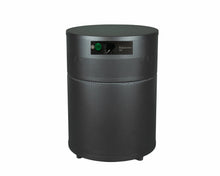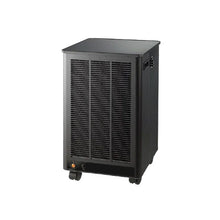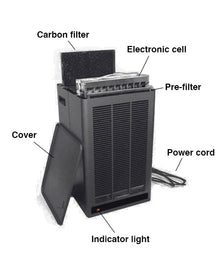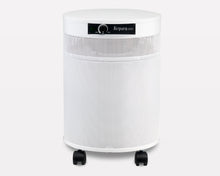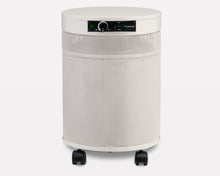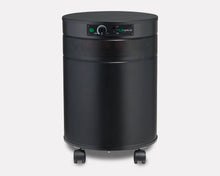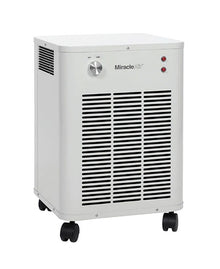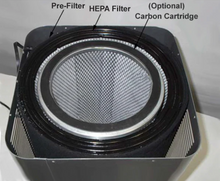Creating a Healthier Workplace: The Comprehensive Guide to Air Purification for Germ, Flu, and Virus Control

Every morning, millions of employees walk into office buildings, conference rooms, and shared workspaces, unknowingly entering environments where airborne pathogens can spread faster than workplace gossip. If you're a facility manager, business owner, or HR professional concerned about keeping your team healthy and productive, you're facing a challenge that goes far beyond traditional cleaning protocols.
The stakes have never been higher. Recent data shows that poor indoor air quality has been tied to symptoms like headaches, fatigue, trouble concentrating, and irritation of the eyes, nose, throat and lungs, while studies demonstrate that poor indoor air quality in buildings can decrease productivity by as much as 6-9%. In this comprehensive guide, you'll discover how strategic air purification can transform your workplace into a healthier, more productive environment while significantly reducing the transmission of germs, flu, and viruses.
The Hidden Health Crisis in Modern Workplaces
The Scope of the Problem
Indoor air quality has emerged as one of the most overlooked yet critical factors affecting workplace health. Air pollution accounted for 8.1 million deaths globally in 2021, becoming the second leading risk factor for death, according to the 2024 State of Global Air Report. While outdoor air pollution often captures headlines, the air we breathe inside our offices, meeting rooms, and shared workspaces can be equally problematic.
The challenge intensifies in commercial environments where multiple people share enclosed spaces for extended periods. Traditional HVAC systems, while designed for temperature control, often fall short of providing the level of air filtration needed to combat modern airborne health threats. This gap becomes particularly concerning during flu season and when respiratory viruses circulate in communities.
Understanding Airborne Transmission in Workplaces
Virus particles do not build up in the air outdoors as much as they do indoors, and some germs spread in the air between people, happening more easily in indoor, crowded spaces, according to the CDC's latest guidance. This reality makes workplaces particularly vulnerable environments for disease transmission.
When an infected person coughs, sneezes, or even speaks, they release respiratory droplets and aerosols containing pathogens. In poorly ventilated spaces, these particles can remain suspended in the air for hours, creating opportunities for transmission long after the infected person has left the area. Conference rooms, break areas, and open office environments become potential hotspots for airborne transmission.
The economic impact extends beyond immediate health costs. Businesses face productivity losses, increased absenteeism, and potential liability concerns when workplace conditions contribute to employee illness. Forward-thinking organizations are recognizing that investing in air quality improvements isn't just about compliance—it's about creating competitive advantages through healthier, more productive work environments.
The Science Behind Effective Air Purification
How Air Purification Combats Pathogens
Modern air purification technology works through multiple mechanisms to remove harmful particles from indoor air. The most effective systems combine several approaches:
HEPA Filtration: High-Efficiency Particulate Air (HEPA) filters represent the gold standard for particle removal. Medical grade HEPA filters (H13 or higher) can clear 99.99% of pollutants like bacteria and viruses from the air. These filters work by forcing air through a dense mesh that traps particles as small as 0.3 microns—smaller than most bacteria and many virus-carrying droplets.
UV-C Sterilization: Ultraviolet-C light technology adds an additional layer of protection by destroying the DNA and RNA of microorganisms, rendering them unable to reproduce or cause infection. This technology is particularly effective against viruses and bacteria that might otherwise pass through or survive on traditional filters.
Activated Carbon Filtration: While primarily known for removing odors and chemical pollutants, activated carbon filters also help create cleaner overall air quality, reducing the total burden of contaminants that can compromise immune system function.
Real-World Effectiveness Data
Recent testing has shown promising results for modern air purification systems. Advanced air purifiers can remove 99.5% of particles as small as 0.003 microns—about 1/4 the size of the SARS-CoV-2 virus and influenza particles, making them particularly useful for cold and flu season protection.
The EPA has also weighed in on the effectiveness of air purification for pathogen control. EPA recommends ventilation and air filtration as part of a larger strategy that includes minimizing close contact, surface cleaning, handwashing, and other precautions to reduce potential airborne transmission of viruses.
Understanding Clean Air Delivery Rate (CADR)
When evaluating air purification solutions for commercial spaces, Clean Air Delivery Rate (CADR) becomes a critical metric. CADR measures the volume of clean air an air purifier can deliver per minute, typically expressed in cubic feet per minute (CFM). For workplace applications, calculating the appropriate CADR involves considering room size, ceiling height, occupancy levels, and air change requirements.
Industry professionals recommend achieving 4-6 air changes per hour in most office environments, with higher rates for spaces with greater occupancy or higher risk factors. This means that all the air in a room should be filtered and cleaned 4-6 times every hour to maintain optimal air quality.
Implementing Strategic Air Purification Solutions
Assessing Your Workplace Air Quality Needs
Before implementing any air purification strategy, conducting a thorough assessment of your current air quality situation is essential. This evaluation should consider several key factors:
Space Configuration: Open offices, private offices, conference rooms, and common areas each present unique challenges and require tailored approaches. High-traffic areas like reception areas, break rooms, and restrooms typically need more robust filtration due to increased occupancy and activity levels.
Occupancy Patterns: Understanding when and how spaces are used helps determine optimal air purifier placement and capacity requirements. Meeting rooms that regularly host presentations or brainstorming sessions may need higher capacity systems due to increased speaking and potential aerosol generation.
Existing HVAC Integration: Modern air purification solutions can work independently or integrate with existing HVAC systems. In-duct purification systems offer whole-building protection, while portable units provide targeted protection for specific areas or temporary needs.
Choosing the Right Air Purification Technology
Different workplace environments benefit from different air purification approaches:
Portable Air Purifiers: These units offer flexibility and can be easily moved to address changing needs. They're particularly effective for smaller offices, conference rooms, or areas where permanent installation isn't feasible. High-quality portable units suitable for commercial use typically feature multiple filtration stages and can handle spaces ranging from 200 to 1,000 square feet effectively.
Ceiling-Mounted Systems: These solutions maximize floor space while providing powerful air cleaning capabilities. They're ideal for open office environments, reception areas, and spaces where aesthetics matter. Ceiling-mounted systems often integrate seamlessly with existing decor while providing superior air circulation patterns.
In-Duct Air Purifiers: For comprehensive building-wide protection, in-duct systems installed within existing HVAC infrastructure offer the most efficient approach. These systems can include UV-C sterilization, advanced filtration, and ionization technologies that treat air before it's distributed throughout the building.
Strategic Placement for Maximum Effectiveness
Proper placement of air purification equipment significantly impacts effectiveness. Key considerations include:
Air Circulation Patterns: Understanding how air moves through your spaces helps optimize purifier placement. Units should be positioned to take advantage of natural air currents while avoiding areas where their intake or output might be blocked by furniture or equipment.
High-Risk Areas: Prioritizing placement in areas where people spend the most time or where transmission risk is highest maximizes health benefits. Conference rooms, break areas, and reception areas typically warrant priority attention.
Maintenance Accessibility: Ensuring that air purifiers can be easily accessed for filter changes and routine maintenance helps maintain long-term effectiveness and reduces operating costs.
Creating a Comprehensive Workplace Health Strategy
Beyond Air Purification: Holistic Approaches
While air purification forms a crucial component of workplace health strategy, the most effective approaches combine multiple elements:
Enhanced Ventilation: CDC released updated guidance for respiratory viruses, which recommended taking steps for cleaner air, along with staying up to date on vaccines for respiratory illnesses such as COVID-19 and flu, as core prevention strategies. Increasing fresh air exchange rates through improved ventilation works synergistically with air purification to maintain healthier indoor environments.
Regular Maintenance Protocols: Establishing routine maintenance schedules for air purification equipment ensures continued effectiveness. This includes regular filter replacements, system cleaning, and performance monitoring to maintain optimal operation.
Employee Education: Helping employees understand the role of air quality in their health and productivity creates buy-in for air quality initiatives and can lead to behavioral changes that support overall workplace health goals.
Measuring Success and ROI
Implementing effective air purification strategies should include mechanisms for measuring success:
Health Metrics: Tracking employee sick days, reported respiratory symptoms, and overall employee satisfaction with air quality provides direct feedback on program effectiveness.
Productivity Measures: Monitoring metrics like meeting attendance, project completion rates, and employee engagement scores can help quantify the productivity benefits of improved air quality.
Air Quality Monitoring: Installing air quality monitors that track particulate matter, volatile organic compounds, and other air quality indicators provides objective data on system performance and air quality improvements.
Cost-Benefit Analysis
The investment in workplace air purification typically pays dividends through multiple channels:
Reduced Healthcare Costs: Fewer employee illnesses translate directly to reduced healthcare utilization and lower insurance costs for organizations that provide health benefits.
Decreased Absenteeism: Healthier employees take fewer sick days, maintaining productivity and reducing the costs associated with temporary replacements or project delays.
Enhanced Recruitment and Retention: Employees increasingly value employers who prioritize their health and wellbeing, making air quality investments a valuable tool for talent management.
Liability Risk Reduction: Proactive measures to maintain healthy workplace environments can help reduce potential liability exposure related to workplace-acquired illnesses.
Implementation Best Practices and Expert Recommendations
Getting Started: A Phased Approach
Implementing comprehensive air purification doesn't need to happen overnight. A phased approach allows organizations to learn from initial implementations and optimize their strategies:
Phase 1: High-Priority Areas: Start with conference rooms, break areas, and other high-occupancy spaces where the risk of transmission is elevated and the impact of improved air quality will be most noticeable.
Phase 2: Individual Workspaces: Expand coverage to open office areas and individual offices, focusing on areas where employees spend the majority of their time.
Phase 3: Comprehensive Coverage: Complete the system with coverage for remaining areas including storage spaces, restrooms, and less frequently used areas.
Professional Consultation and Support
Working with air quality professionals can help ensure optimal system selection, placement, and maintenance. Experienced consultants can conduct air quality assessments, recommend appropriate technologies, and design maintenance programs that keep systems operating at peak effectiveness.
Many organizations benefit from partnering with suppliers who offer comprehensive support including installation, training, and ongoing maintenance services. This approach ensures that air purification investments continue to deliver benefits over the long term.
Maintenance and Long-Term Success
Sustainable air purification programs require attention to long-term maintenance and operation:
Filter Replacement Schedules: Establishing and adhering to regular filter replacement schedules ensures continued effectiveness and prevents systems from becoming sources of contamination themselves.
Performance Monitoring: Regular assessment of system performance through air quality testing and employee feedback helps identify issues before they compromise effectiveness.
Technology Updates: The air purification industry continues to evolve, with new technologies and improved efficiency becoming available. Periodic assessment of available technologies ensures that organizations can take advantage of improvements and maintain state-of-the-art protection.
Frequently Asked Questions About Workplace Air Purification
Q: How often should air purifier filters be changed in commercial settings? A: Filter replacement frequency depends on usage levels, air quality conditions, and manufacturer specifications. In typical office environments, HEPA filters should be changed every 6-12 months, while pre-filters may need monthly replacement. High-usage areas or environments with poor outdoor air quality may require more frequent changes.
Q: Can air purifiers completely eliminate the risk of airborne disease transmission? A: While air purifiers significantly reduce airborne pathogens, they should be part of a comprehensive health strategy rather than a standalone solution. Combined with proper ventilation, hygiene practices, and other preventive measures, air purification can substantially reduce transmission risk but cannot eliminate it entirely.
Q: What size air purifier do I need for my office space? A: Air purifier sizing depends on room volume, occupancy levels, and desired air change rates. A professional assessment considering these factors will ensure appropriate sizing. As a general guideline, plan for 4-6 air changes per hour in typical office environments.
Q: Are there any maintenance requirements for UV-C air purification systems? A: UV-C systems require periodic lamp replacement (typically annually) and regular cleaning of lamp surfaces to maintain effectiveness. Professional maintenance ensures optimal UV-C output and system safety.
Q: How can I measure the effectiveness of my air purification system? A: Air quality monitors can track particle counts, while employee health metrics and satisfaction surveys provide feedback on real-world effectiveness. Professional air quality testing can provide detailed analysis of system performance.
Conclusion: Taking Action for Healthier Workplaces
Creating a healthier workplace through strategic air purification isn't just about purchasing equipment—it's about implementing a comprehensive approach that considers your unique space, occupancy patterns, and health goals. The evidence is clear: poor indoor air quality can decrease productivity by 6-9%, while effective air purification systems can remove 99% or more of harmful particles from workplace air.
The investment in workplace air quality pays dividends through reduced employee illness, increased productivity, enhanced employee satisfaction, and reduced liability exposure. As respiratory viruses continue to pose challenges and awareness of air quality impacts grows, organizations that proactively address workplace air quality position themselves for competitive advantages in health, productivity, and talent management.
Ready to take the next step toward a healthier workplace? Start by assessing your current air quality situation and identifying high-priority areas for improvement. Whether you're looking for portable solutions for individual offices or comprehensive systems for entire facilities, the right air purification strategy can transform your workplace into an environment where employees thrive.
For expert guidance on selecting and implementing air purification solutions tailored to your workplace needs, explore the comprehensive range of commercial-grade air purifiers and consultation services available at commercialairpurifiers.net. Your employees' health and your organization's success depend on the quality of the air they breathe every day.
The information in this article is based on current research and industry best practices. Consult with air quality professionals for specific recommendations tailored to your facility's unique needs.

